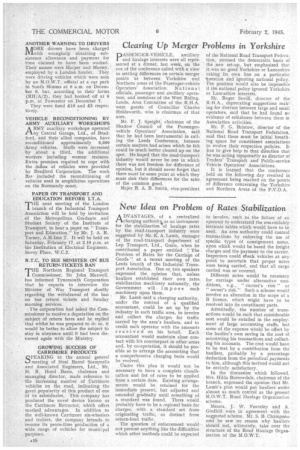New Idea on Problem of Rates Stabilization A DVANTAGES of
Page 20

If you've noticed an error in this article please click here to report it so we can fix it.
a centralized tAcharging autho-r-it3i as an instrument for the stabilization of haulage rates by the road-transport industry were suggested by Mr. K. A. Lamb, manager of the road-transport department of Lep Transport, Ltd., Goole, when he
contributed a paper entitled The Problem of .Rates for the Carriage of Goods" at a recent meeting of the Leeds branch of the Industrial Transport Association. One or, two speakers expressed the opinion that, unless hauliers established their own rates stabilization machinery nationally, the Government will imp o se such machinery upon them.
Mr. Lamb said a charging authority, under the control of a qualified accountant, could be set up by the industry in each traffic area, to invoice and collect the charges for traffic carriedby the area's hauliers, and to credit each operator with the amounts r ec e iv ed on his behalf. Each accountant would maintain close contact with his counterpart in other areas and, by co-operation, it should be -possible so to arrange the accounting that a comprehensive charging basis would be evolved.
Under this plan it would not be necessary to have a complete classification and list of rates to be applied from a certain date. Existing arrangements would be retained for the immediate present, but adjusted and amended gradually until something of a standard was found. There would probably have to be a regional basis for charges, with a standard set fromoriginating traffic, as distinct from return-load traffic.
The question of enforcement would not present anything like the difficulties which other methods could be expected to, involve, such as the failure of an operator to understand the unavoidably intricate tables which would have to be used. An area authority could control transactions by enforcing the use of specific types of consignment notes, upon which would be based the freight charges and the payment to the carrier. Inspectors could eteck vehicles at any point to ascertain that proper notes were being carried, and that all cargo carried was so covered.
Different notes would be necessary for carriage under alternative con ditions, e.g.,. " carrier's risk " or " owner's risk:" Such a scheme would involve an alteration in the scope of a B licence, which might have to be resolved into its constituent parts.
Admittedly, the number of transactions would be such that considerable cost would be entailed in the employment of large accounting staffs, but • some of the expense Would be offset by the haulier's own saving in the cost of accounting his transactions and collect ing his accounts. The cost would have to be met by a contribution from the hauliers, probably by a percentage -deduction from the periodical payments to him, although this method would not be entirely satisfactory.
In the discussion which followed, Mrs. Hilda Borrowdale, chairman of the branch, expressed the opinion that Mr. Lamb's plan would put hauliers under almost as much control as the present M.O. W .T. Road Haulage Organization scheme.
Messrs. J. W. Fearnley and A. Gledhill were in agreement with the suggested scheme. Mr. S. B. Chimpnass said he saw no reason why hauliers should not, ultimately, take over the structure of the Road Haulage Organization of the M.O.W.T.




















































